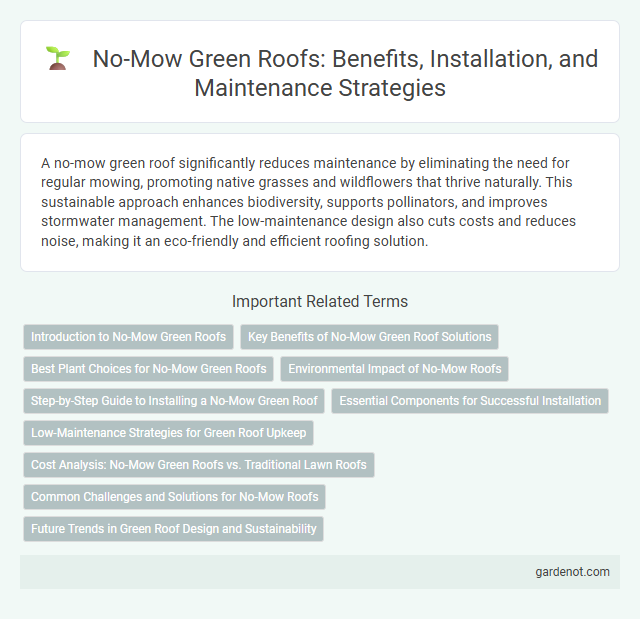A no-mow green roof significantly reduces maintenance by eliminating the need for regular mowing, promoting native grasses and wildflowers that thrive naturally. This sustainable approach enhances biodiversity, supports pollinators, and improves stormwater management. The low-maintenance design also cuts costs and reduces noise, making it an eco-friendly and efficient roofing solution.
Introduction to No-Mow Green Roofs
No-mow green roofs are innovative urban solutions designed with low-maintenance, drought-tolerant vegetation that thrives without regular mowing or trimming. These roofs enhance biodiversity, improve stormwater management, and reduce urban heat island effects while minimizing maintenance costs and resource use. Incorporating native grasses, sedums, and wildflowers, no-mow green roofs create sustainable ecosystems that support pollinators and promote environmental resilience.
Key Benefits of No-Mow Green Roof Solutions
No-mow green roof solutions reduce maintenance costs by eliminating the need for regular mowing, which also decreases fuel consumption and carbon emissions. These roofs promote biodiversity by providing a habitat for native plants and pollinators while improving stormwater management through enhanced water retention. Their drought-resistant plant selection ensures long-term resilience and energy efficiency by insulating buildings and lowering cooling costs.
Best Plant Choices for No-Mow Green Roofs
Sedum species, such as Sedum acre and Sedum album, are ideal for no-mow green roofs due to their drought tolerance and low maintenance requirements. Native grasses like Festuca ovina and drought-resistant wildflowers, including Eriogonum spp., thrive in shallow substrates and provide ecological benefits. Incorporating these resilient, low-growing plants ensures sustainable, water-efficient green roofs that require minimal upkeep.
Environmental Impact of No-Mow Roofs
No-mow roofs significantly reduce carbon emissions by eliminating the need for gas-powered lawnmowers, contributing to improved air quality and lower greenhouse gas output. These low-maintenance green roofs enhance urban biodiversity by providing habitats for pollinators and native plant species, supporting ecological balance. Water retention capabilities of no-mow roofs mitigate urban runoff, decreasing the risk of flooding and promoting groundwater recharge.
Step-by-Step Guide to Installing a No-Mow Green Roof
A no-mow green roof installation begins with selecting drought-resistant sedum or native grasses suited for minimal maintenance. Next, install a waterproof membrane and proper drainage system to prevent water damage and promote healthy root growth. Finally, layer lightweight growing medium and carefully plant vegetation, ensuring consistent watering during the initial establishment phase for long-term sustainability.
Essential Components for Successful Installation
No-mow roofs require a carefully engineered growing medium that supports drought-tolerant, low-maintenance plant species to ensure long-term health and minimize irrigation needs. A high-quality drainage layer is essential to prevent waterlogging and provide adequate moisture retention while promoting root aeration. Proper waterproofing membranes, root barriers, and edge restraints are critical components to protect the building structure and maintain the roof system's integrity.
Low-Maintenance Strategies for Green Roof Upkeep
No-mow roofs utilize drought-tolerant sedums and native grasses to minimize water use and mowing needs, making them ideal for low-maintenance green roofs. Incorporating a well-draining substrate and a sturdy waterproof membrane reduces plant stress and extends roof lifespan. Strategic planting patterns and seasonal inspections help prevent weed growth and nutrient depletion without intensive care.
Cost Analysis: No-Mow Green Roofs vs. Traditional Lawn Roofs
No-mow green roofs offer significant cost savings compared to traditional lawn roofs by reducing maintenance expenses such as mowing, irrigation, and fertilization, which typically account for up to 40% of annual upkeep costs. Installation costs for no-mow roofs are generally higher due to specialized drought-resistant plants and substrate layers, but these are offset over time by lower operational costs and extended roof membrane lifespan. Long-term financial benefits include reduced water usage, decreased labor requirements, and minimized environmental impact, making no-mow green roofs a cost-effective sustainable landscaping solution.
Common Challenges and Solutions for No-Mow Roofs
No-mow roofs often face challenges such as weed invasion, uneven plant growth, and maintenance difficulties due to limited accessibility. Implementing drought-resistant, low-maintenance vegetation like sedum or native grasses helps reduce water requirements and minimize upkeep. Regular monitoring and targeted spot treatments effectively control weeds and ensure healthy plant coverage without the need for traditional mowing.
Future Trends in Green Roof Design and Sustainability
No-mow roofs represent a significant trend in future green roof design by minimizing maintenance while promoting biodiversity and water conservation. These low-growing, drought-resistant plant species reduce the need for mowing, lowering carbon emissions and operational costs. Integrating no-mow roofs with smart irrigation systems and sustainable materials enhances urban resilience and supports climate adaptation strategies.
No-mow roof Infographic

 gardenot.com
gardenot.com